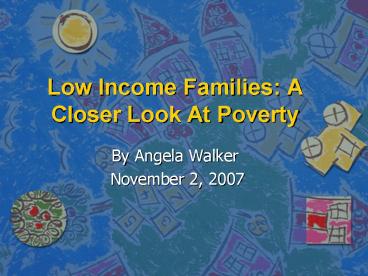Low Income Families: A Closer Look At Poverty - PowerPoint PPT Presentation
1 / 18
Title:
Low Income Families: A Closer Look At Poverty
Description:
The purpose of this Power Point presentation is to inform the challenges that ... The facts and figures were astonishing. http://www.urban.org. Websites ... – PowerPoint PPT presentation
Number of Views:78
Avg rating:3.0/5.0
Title: Low Income Families: A Closer Look At Poverty
1
Low Income Families A Closer Look At Poverty
- By Angela Walker
- November 2, 2007
2
Introduction
- The purpose of this Power Point presentation is
to inform the challenges that poverty stricken
children pose for teachers. There are millions
of children around the world living in poverty
and as future teachers we will have to help our
students over come the strains on learning that
comes with living in poverty. No one benefits
educationally by being born poor.
3
Overview
- The next set of slides will include an overview
of the research collected including what its
like living in poverty, geography of low-income
families, how poverty effects children, and how
teachers can help children living in poverty.
4
What Its Like Living In Poverty
- Poverty is defined as 20,650 a year for a family
of four. - Children in low-income families were twice as
likely to face moving in the past year compared
to children in higher-income families. - Most of these families move to find better paying
jobs.
5
What Its Like Living In Poverty (Continued)
- Families living in poverty live in the moment
because survival is their top priority. Their
energies are consumed with simply getting through
each day and making sure there is food on the
table and lights on in the house. - Families living in the middle class live with
their eye to the future, where achievement is the
top priority. - To middle class families education is crucial for
financial success. - To poverty families education is abstract, but
its not considered a long-term reality.
6
Geography of Low-income families
- 41 of children in low-income families live in
the South, up from 37 a decade ago. - 26 live in the West, up from 23 a decade ago.
- Over 40 of children in low-income families moved
to the South.
7
How Poverty Affects children
- Children whose families live below poverty and
with lower levels of family income are less
likely to participate in extracurricular
activities and to be academically on track than
children with higher levels of family income. - Children living in poverty are more likely to
drop out of school, bear children out of wedlock,
and have trouble keeping a jobs as young adults. - Single mothers with dependent children have the
highest rate of poverty.
8
What Teachers Can Do To Help
- Schools must become the catalytic support system
that transitions students from poverty to
prosperity. - Many children born into poverty are concentrated
in struggling schools across the country. - High-quality teachers and administrators and a
synergistic blend of the most effective
traditionalist and progressive ideas are needed
to be more effective schools.
9
What Teachers Can Do To Help (Continued)
- Should teachers receive incentive pay for
improving student performances? - U.S. secretary of education Margaret Spellings
announced the first handout of the Teacher
Incentive Fund, a federal grant program that
offers cash bonuses to teachers and principals
who succeed in improving their students
achievement.
10
Websites
- The George Lucas Educational Foundation was
founded in 1991 as a nonprofit foundation to
encourage innovations in schools. - This site would be great for parents or teachers.
- This site had many polls that parents or teachers
could participate in and post their thoughts. - http//www.edutopia.org
11
Websites
- The Ohio State University, College of Education
and Human Ecology is a website that gives
resources to solve complex societal problems that
affect the quality of life, especially in urban
settings. - Parents, teachers, and psychologist would find
this website helpful. - The research topics are great.
- http//www.hec.ohio-state.edu
12
Websites
- The Urban Child Institute is a website devoted to
giving a voice to children. - This website is great for parents and teachers.
- The blogs give great information about many
topics that affect children. - http//www.theurbanchildinstitute.blogspot.com
13
Websites
- The Urban Institute is a website that publishes
studies, reports and books on topics that affect
the public. - Teachers, parents, and psychologist would find
the reports helpful. - The facts and figures were astonishing.
- http//www.urban.org
14
Websites
- National Center for Children in Poverty (NCCP) is
a website that puts research to work for children
and families. - Parents and teachers would enjoy this website.
- Lots of great facts on many different topics that
affect children. - http//www.nccp.org
15
Articles
- Restructuring High-Poverty Elementary Schools for
Success A Description of the Hi-Perform School
Design - Stanley Pogrow is the author of this article.
- This article outlines the basic structure of the
kind of school that will help children of poverty
gain ground and so reduce learning gaps. - This article is useful for parents and teachers.
16
Articles
- Understanding Poverty
- Cindy Long is the author of this article.
- This article tells about a workshop for teachers
that helps close the achievement gap. - Teachers would find this article useful.
17
Conclusion
- Poverty is a very delicate situation to deal with
in the classroom. A teacher cannot ignore the
fact that a child is coming from a background of
poverty. Teachers must look at every child
individually. It will be my job as a teacher to
make these children feel like they are just as
good as an other child in the classroom.
18
References
- Long, Cindy (2006). Understanding Poverty. NEA
Today,24(7),16. - Pogrow, Stanley (2006). Restructuring
High-Poverty Elementary Schools for Success A
description of the Hi-Perform School Design. Phi
Delta Kappan, 88(3),223. - http//www.edutopia.org
- http//www.hec.ohio-state.edu
- http//www.theurbanchildinstitute.blogspot.com
- http//www.urban.org
- http//www.nccp.org































